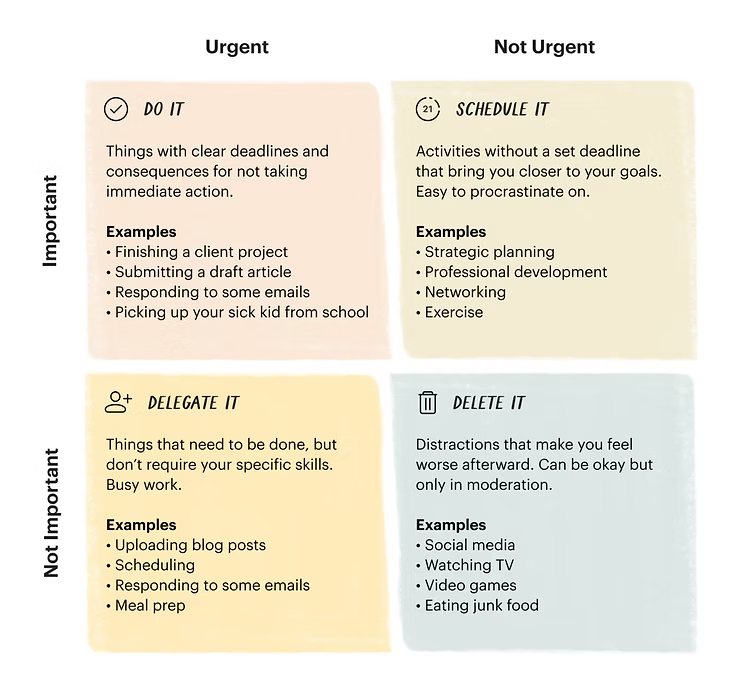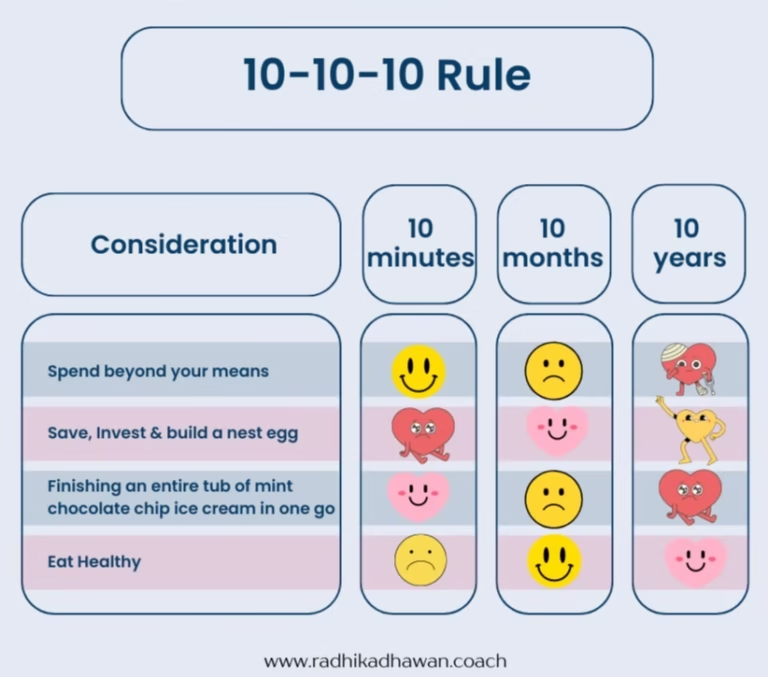Eisenhower Matrix: A system to prioritise your time
In the pursuit of personal growth and enhanced productivity, the right tools can be transformative. One such enduring tool is the Eisenhower Matrix, named after Dwight D. Eisenhower. This matrix aids in prioritising tasks by differentiating between urgency and importance. In this blog let’s explore the history, functionality and benefits of the Eisenhower Matrix and how it can help you achieve your goals.

The bad news is time flies. The good news is you’re the pilot. – Michael Altshuler
Dwight D. Eisenhower was a remarkably productive individual and was known for his remarkable ability to manage time and prioritise tasks. During his two terms as the 34th president of the United States (1953 – 1961), e spearheaded the construction of the Interstate Highway System, established NASA, enacted the first significant civil rights legislation since the Civil War, brought an end to the Korean War, welcomed Alaska and Hawaii into the union, launched the peaceful use of alternative energy sources (Atomic Energy Act) and successfully managed to maintain a peaceful Cold War with Russia.
Before his presidency, Eisenhower served as a five-star general during World War II, commanding the Allied Forces in Europe. His leadership was crucial in planning and executing major military operations, including the D-Day invasion.
At other times, he also held the position of President at Columbia University, was appointed as the inaugural Supreme Commander of NATO and managed to somehow dedicate time to pursue hobbies like golfing and oil painting.

What is the Eisenhower Matrix?
The Eisenhower Matrix, also known as the Urgent-Important Matrix, is a simple yet powerful tool to help you prioritise tasks based on their importance and urgency. By dividing tasks into four quadrants, it helps you focus on what really matters and avoid getting bogged down by less significant activities.
Eisenhower was known for his impressive productivity not just in the short term, but over decades. Many have studied his time management and decision-making techniques. His approach was later formalised into the Eisenhower Matrix, which gained popularity through Stephen Covey’s influential book, “The 7 Habits of Highly Effective People.”
The Difference Between Urgent and Important
Eisenhower famously said, “What is important is seldom urgent and what is urgent is seldom important.”
Understanding the difference between urgent and important is key to using the Eisenhower Matrix effectively.
Important Tasks: These contribute to your long-term goals and values. They are tasks that, when completed, bring you closer to achieving significant outcomes.
Urgent Tasks: These require immediate attention and are often associated with achieving someone else's goals. They are tasks that demand your immediate focus and can cause stress if not addressed promptly.
By distinguishing between these two, you can make more informed decisions about how to spend your time.
The Four Quadrants of the Eisenhower Matrix
Quadrant 1: Urgent and Important – DO
Tasks that require immediate attention and have significant consequences. These are the tasks you need to tackle right away.
Example: Handling a critical client issue or meeting an imminent project deadline.
Quadrant 2: Important but Not Urgent – SCHEDULE
Tasks that are important for long-term success but do not require immediate action. These tasks need strategic planning and focus.
Example: Setting goals for the next quarter or working on personal development.
Quadrant 3: Urgent but Not Important – DELEGATE
Tasks that require immediate attention but do not contribute significantly to your long-term goals. These tasks can often be delegated.
Example: Responding to non-essential emails or attending unnecessary meetings.
Quadrant 4: Not Urgent and Not Important – DELETE
Tasks that are neither urgent nor important. These activities are often distractions that can be minimised or eliminated.
Example: Mindlessly scrolling through social media or watching TV shows.

How to Start Using the Eisenhower Matrix
- List Your Tasks: Write down all the tasks you need to complete.
- Categorise Tasks: Assign each task to one of the four quadrants.
- Prioritise and Plan: Focus on Quadrant 1 tasks first. Allocate time for Quadrant 2 tasks to ensure they don’t become urgent. Delegate or say no to Quadrant 3 tasks. Minimize or eliminate Quadrant 4 tasks.
- Review Regularly: Regularly review and adjust your tasks to ensure you stay on track.
Benefits of the Eisenhower Matrix
- Increased Productivity: By focusing on what truly matters, you can accomplish more meaningful work.
- Better Time Management: Helps you allocate your time efficiently and avoid spending time on non-essential tasks.
- Reduced Stress: Knowing which tasks to prioritize can significantly reduce stress and prevent burnout.
- Improved Decision Making: Provides a clear framework for making decisions about how to spend your time.
Does This Help Me Accomplish My Goal?
Using the Eisenhower Matrix can significantly enhance your ability to accomplish your goals. By prioritising tasks that are important but not urgent, you ensure that you make consistent progress towards your long-term objectives. This proactive approach helps you stay ahead of deadlines, reduces the likelihood of last-minute crises, and allows you to focus on activities that align with your values and aspirations.
Example in Action
Let’s say you’re an entrepreneur with the following tasks:
- Prepare for a client presentation (Q1)
- Plan next month’s marketing strategy (Q2)
- Answer routine emails (Q3)
- Browse online for new office furniture (Q4)
Using the Eisenhower Matrix, you’d first tackle the client presentation, then allocate time for planning the marketing strategy. You’d delegate the email responses to an assistant and avoid spending too much time browsing online.
By systematically applying the Eisenhower Matrix, you can ensure that your daily actions contribute to your overall success and fulfilment.
Clarifying Your Purpose
Eliminating time-wasting activities can be challenging if you’re unsure about your goals.
Two questions can clarify the process behind the Eisenhower Matrix:
- What am I working toward?
- What are the core values that drive my life?
I have asked myself these questions and answering them has helped me clarify the categories for tasks in my life. Deciding which tasks to do and which to delete becomes easier when you are clear about what is important to you.
Final Thoughts
The Eisenhower Matrix is a timeless tool that can help you gain clarity, overcome procrastination and stay accountable to your goals. By using this matrix, you can develop a growth mindset, set and achieve meaningful goals and ultimately lead a more productive and fulfilling life.
While the Eisenhower Matrix may not be perfect, it is a useful decision-making tool that has increased my productivity and eliminated behaviours that waste time and mental energy.
Remember, it’s pretty simple: Prioritise what matters, delegate what doesn’t and eliminate distractions. Start using the Eisenhower Matrix today and take control of your time and productivity!



